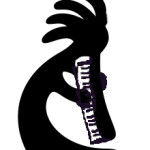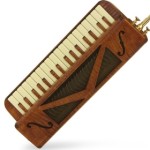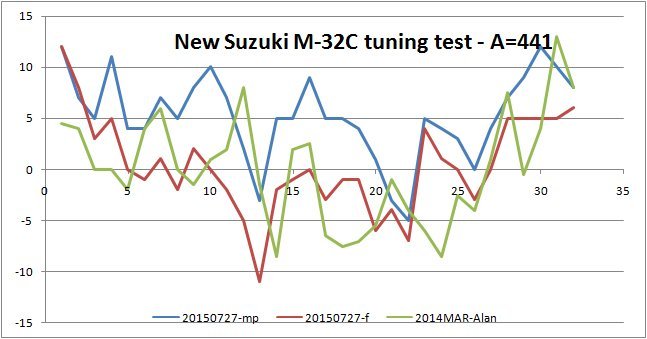Tuning Standard
Tagged: tuning
- This topic has 31 replies, 8 voices, and was last updated 8 years, 8 months ago by
 Melodica-Me.
Melodica-Me.
-
AuthorPosts
-
March 26, 2014 at 5:50 am #2007
 Melodica-MeParticipant
Melodica-MeParticipantIn some cases if the reed is defective you will tune and it will not stay in tune. I recently had my Vibrandoneon tuned and I had to replace a reed that would not stay tuned. If a reed has been stressed (blown to hard) it will tune then as it warms up fall out of tune. When tuning for chords like in a guitar you have overtones or harmonica that you tune to for a more full sound or sometimes a tighter sound depending on the tuning. If you have a guitar go close to the sound hole and barely touch the string then pluck you will here a ping or high pitch tone(harmonic) you can tune to that if you know the note and harmonic to another string below or above. This does not work for the melodica only string instruments that can sustain a tone. Tuning an instrument by ear requires a bit of practice and more training of the ear than the practice of scraping a reed. The first instrument I learned to tune was my Wurlitzer electric piano, not my favorite thing to do but back then it was a $35 dollar service charge just to open it and look, this was 1970 and $35 bucks was a lot of money so I learned to do it. Now I pay a $100 buck and they tune and adjust the entire Vibrandoneon, well worth it. To know how to tune your melodica is a good thing, I have a couple of beater melodicas that I am planning on practicing on so if I bust a reed que sera sers.
Melodica-MeMarch 26, 2014 at 5:11 pm #2008 Alan BrintonParticipant
Alan BrintonParticipantI have broken one reed, Melodica-Me. I’m sure it was failed or defective, because it suddenly went seriously flat and then the same happened again after I tuned it up. I broke the reed by lifting on the end trying to widen the gap. I think the greatest danger is from filing crosswise or from catching the reed tip while filing at the open end; the scraping or filing motion at the open end should always be in line with the reed and toward the end, and it’s important not to pull the file back carelessly at that end.
I agree with you that the scraping or filing is the easy part; getting clear readings with a meter or by ear before tuning and after scraping is the hard part, obviously easier the better your ear is. Some of the tuning apps have an ear training function.
March 26, 2014 at 9:29 pm #2009 KevinParticipant
KevinParticipantI agree that stretch tuning isn’t appropriate for the melodica. It’s mostly in the highest and lowest ends of the piano the stretching occurs. In the middle where the melodica lives the notes are I believe standard.
I’m curious about the technique you guys are using?
Do you Scape and then completely reassemble?
I tried using pieces of electrical tape to cover all the screw holes on the air-chamber cover. Then while wedging the key open with something and using the hose I hold the cover down with both hands and test the note. I don’t have the patience to screw the thing back together over and over for every note.
The issue I’m running into is how tight I hold the cover has a bearing on how the notes sound. Unless I hold the cover as tight as I can I often find the reed is no longer in tune when I do put the screws back in.
I assume it’s similar to bending a note.
Also I always use sandpaper never a file. Similar to this tutorial:
I always thought that a file would be too destructive?As far as tuning by ear. I try to make sure the octaves are consonant. No matter what the needle says I check the octaves by ear.
Alan, I feel a little guilty for convincing you to tune in 440. If you are going to play solo I think it’s acceptable to bring a melodica in tune with itself.
March 26, 2014 at 11:17 pm #2010 Alan BrintonParticipant
Alan BrintonParticipantYou were doing me a favor, Kevin, since I play along a lot with favorite recordings and with band-in-a-box. In fact, I was so impressed with the new sound of my Suzuki M-32C that I spent several hours today re-tuning my favorite P-32D Pianica to A440. Also, sometimes I have the opportunity to play along with a piano.
I’ve seen that video and others by that guy. He’s quite a character. I would be worried about sand from the sandpaper getting into my melodica, and his arrangement for it seems awkward. I’m abrading and scratching more than scraping, lightly of course. It’s just a matter of lightly removing some material. I noticed that some of the factory tuning is in the form of random scratches that look like they have been done with a sharply pointed tool of some kind.
I don’t put the whole melodica back together, but I do tightly screw down the reed chamber cover, which I had to do and undo about 8 times today with my pianica. I start by getting readings for all the notes, going through that process several times until I’m satisfied that my final readings are in the right vicinity, with special attention to any extreme readings and to wide divergences. I then focus on just the notes that are more than 3 cents off the standard. Then I open the melodica up and scrape all the reeds, guestimating how much to scratch/scrape them in relation to how far off they were. Then I screw the cover back on and go through the “readings” process. Then focusing again just on the notes that are still 3 cents +/- off, I remove the cover and do more scraping in proportion to how far off the remaining reeds are. I repeat this whole thing as many times as is necessary, sometimes doing a tiny bit more scratching on reeds that are almost 3 cents off.
My guess is that factory tuners just take note of reeds that are not within some margin, go in and do some scraping, and call it good. Obviously some of them would get better results than others.
The whole process is laborious and can get very frustrating, so I need to take some breaks and go do something else. But it’s a kind of thing I enjoy doing and find satisfying.
I’ve heard that some people use a dremel. I got one for Christmas, but when I showed my daughter who makes jewelry the reed plates of a melodica, she advised me against using it for that purpose.
March 27, 2014 at 7:24 pm #2013 KevinParticipant
KevinParticipantI’m glad that worked out favorably Alan.
I’ve seen people argue for being a little sharp, but to my ears being in sync with the rest of the band really makes a sweeter sound.
I’m wondering still about the reed chamber? I’ve had a couple instances where I altered the tuning just by re-seating the cover differently. Such as tightening the screws from left to right instead of left to right or tightening the center screw first etc.
I have a Dremel but never thought of using it for tuning. I’m like your daughter, I was afraid I would grind the reed in two before I knew it.
What I think would be great is some sort of single reed isolation cover that connects to the hose. That way I could lay the melodica down, leave it open, place the cover over a single reed to test it, file a little, test again, file a little, etc.
I experimented on this idea a little but haven’t gotten too far. There’s only so much precision one can have with duct tape Ha,ha.
I had read where someone suggested placing your lips over a single reed and blowing which accomplishes the same effect. I’m hesitant to do that I didn’t want to get metal filings and bit’s of sandpaper grit into my mouth and prolonged exposure to brass isn’t good for you.March 27, 2014 at 10:44 pm #2016 Alan BrintonParticipant
Alan BrintonParticipantThere’s another alternative, Kevin, that I read about but have not tried. It’s to use a guitar pickup and ping the reed. I ping my reeds with a flexible plastic toothpick. Whether harsher pinging would be required and might be risky I don’t know. Your idea might work if the little enclosure didn’t produce bending. I suspect that pinging would produce the most accurate results, but what I suspect often turns out to be false.
March 28, 2014 at 2:43 am #2020 LowboyParticipant
LowboyParticipantYou guys are killing me with tuning talk. I like it and hope to dig in one of these days. Here are a couple of thoughts.
The harmonica tuning videos on the Hohner website are filled with conceptual information directly related to tuning melodicas. They recommend pinging the reeds several times after bending for gap adjustment to enable the reed to settle into its final position. Then adjust and ping again if needed.
In the PR video for the Hohner Museum and/or the history of Hohner (found on the corporate website or museum website or both), they show a few seconds of a reed plate being tuned. Tuning only took a couple second per reed. I was not sure if the reed plate was bare or mounted in a harp or melodica, but it was open to the air to enable metal removal, somehow air was being blown through the reed to make it sound.
I thought they must either be blowing air from the back side or maybe shooting a stream of compressed air from the front directly at the reed. This would save having to adjust the tuning blind and then having to reassemble to test your work. One of these days I will shoot compressed air at a reed when I have my air compressor operating.
Lowboy
March 28, 2014 at 2:47 am #2021 LowboyParticipant
LowboyParticipantThe tuning videos are on the USA Hohner website (Hohner Shop). The history of Hohner PR video is on the world wide website I think.
Lowboy
March 28, 2014 at 3:55 pm #2023 KevinParticipant
KevinParticipantI saw the video Lowboy. The thing is you can tune a harmonica reed plate in the open like that. If you remove the chrome covers from your harmonica you can see the reeds and they still play. The melodica is constructed in a way as if a harmonica was turned inside out. the air is flowing the other way across the reeds. I have thought of removing the reed plates tuning them and putting them back but most models seemed to be glued in place and I’m also not sure if all the re-seating will change the air-pressure.
I’ve thought of doing some sort of harmonica/melodica conversion where I’d run a set of tubes from the keys to the individual reed cells on a harmonica.
I’m not sure why a company hasn’t tried a harmonica-like design. I suspect the manufacturing cost would be higher?April 1, 2014 at 5:57 pm #2049 Alan BrintonParticipant
Alan BrintonParticipantTuning Tip: Fooling around with my P-24F this morning. It’s harder to get consistent readings at the bottom end. I decided to play a couple of tunes while watching the VU meter to see where the needle jumps and resides during the playing of each note. I am finding this to be very helpful. It’s a simple thing that other people are already doing and that I had done before, but this time I did it for all the keys.
I have watched the Hohner tuning videos and also found them very helpful. But I’ll watch them again.
June 20, 2015 at 12:32 pm #5501 QuetscherParticipant
QuetscherParticipantJust found an interesting and funny article about tuning standards that I wanted to share (as if there wasn’t enough confusion about that topic!!!).
July 28, 2015 at 1:30 am #5713jeff
ParticipantI just jumped into melodica land with the purchase of a Suzuki M-32C new from Japan. Tuning is important to me, as I want to include melodica into the bands I play with which are quite varied from Bluegrass–>Rock and Roll–> Jazz –> Soul. Most of the guys I play with are picky about tuning…I generally show up with a keyboard (Nord Electro and/or accordion) and woodwinds (mostly bigger saxophones and flute). I also have a Fender Rhodes in my studio…I maintain all these and have a small repair business where I mostly work on saxophones and vintage electromechanical pianos (Rhodes, Wurlitzer, B-3, etc…). As many have alluded to, I need to figure out the tuning thing before I expose my bandmates to this beast. Please complain if you want, but I will be posting my experience here in this tuning thread…this is the first edition.
The chart below shows the first careful data taken on my Suzuki M-32C…I tested it at both mezzopiano (the quietest that I could get a steady reading) and forte (the loudest where I could get a steady reading). I tuned at A=441 as this is where most bands I play with set up. It allows for some warmup and rarely are any instruments flatter than A=440. Keep in mind in this range, 1 Hz is about 4 cents of tuning. I also included a chart that Alan Brinton kindly shared with me from a year or so back on another modern M-32C.

As you can see, both of these horns (my reference) seem to be ‘centered’ at A=441. Alan’s data was taken at A=440, so I corrected it by 4 cents. For my horn, red is LOUD and blue is soft, Alan’s data is in green. Note his data roughly tracks with my horn and falls in between my loud and soft curves. Quite a wide curve at the extremes. Looks like about 5 cents between loud and soft.
I’m going to try and set up with regulated pressure feed and test a couple of ranges after I blow it for a few hours and see if it is ‘settling in’. Stay tuned…
July 28, 2015 at 9:03 am #5720 Alan BrintonParticipant
Alan BrintonParticipantRegulated pressure is a great idea, jeff. I’m curious as to the source of air pressure. Something steady and quiet, right? Would an adjustable fish tank air pump work? something like this?
or this?
July 29, 2015 at 2:09 am #5722 LowboyParticipant
LowboyParticipantHi Alan,
I know from being a former fish owner that aquarium air pumps can make noise. They can hum. Some are pretty quiet when placed on a solid surface, and some are not so quiet. Whether they are sufficiently loud to interfere with tuning is an unknown, but you could always cover them with something to deaden the sound if you get a loud one. Lowboy
July 29, 2015 at 3:35 am #5723 Alan BrintonParticipant
Alan BrintonParticipantI discussed this today with an engineer, and he suggested using air from a pressurized tank so as to avoid pumping.
-
AuthorPosts
- You must be logged in to reply to this topic.
